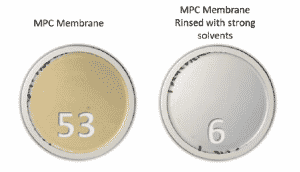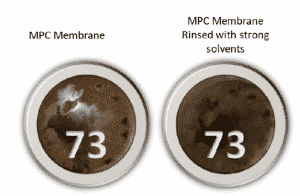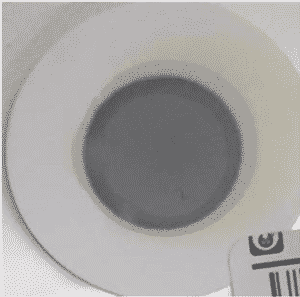
Can MPC Tests Become Part of a Standardized CM Program for Hydraulic Oils?
Varnish is common in most oils, especially turbine oils, compressor oils, gear oils and hydraulic oils. Typically, the suite of tests used to monitor the onset of varnish in oils requires a large volume of oil from the system (in some cases more than 1 liter of oil). However, there are some hydraulic sumps which are smaller in size and the removal of this large volume of oil is almost equivalent to draining the sump! Does this mean that we cannot do condition monitoring for varnish in hydraulic oils?
Varnish and Hydraulic oils
Hydraulic oils have special functions. They are responsible for transmitting power, lubricating components, transferring heat and of course carrying away contaminants from critical surfaces. Usually, contamination is one of the main reasons for hydraulic equipment failures. This is attributed to the very small clearances in hydraulic equipment. These small clearances can easily get blocked and cause the equipment to fail. Apart from contaminants, varnish deposits can also cause blockages in hydraulic equipment.
Varnish usually produces a sticky, tenacious residue which can cause valves to stick. It can also act as an insulator which prevents the oil from providing its cooling function. This can lead to hotter, less efficient systems with fouled filters and plugged lines especially due to the small clearances. Hydraulic applications are all around us from mining shovels to plastic injection moulding machines, even in amusement park rides. Varnish deposits can create significant cost and safety issues.
Condition monitoring for Hydraulic oils
One method of taking proactive action against varnish is to establish a condition monitoring program whereby the condition of the oil can be monitored and users alerted accordingly. A typical condition monitoring program to monitor varnish may include the following tests:
- Voltammetry, RULER (ASTM 6971) – used to identify the health of the antioxidants both primary and secondary (ZDDP) which are found in hydraulic oils.
- Molecular Spectroscopy using Fourier Transform Infrared (FTIR) – for hydraulic oils, there are two methods which can be used:
- ASTM D7414 – measures oxidation
- ASTM D7412 – measures antiwear additives
- Membrane Patch Calorimetry, MPC (ASTM D7843) – determines the oil’s propensity to form varnish.
- Ultracentrifuge (UC) – measures the amount of degradation products which have been extracted through high centrifugal forces. This can predict the onset of varnish in hydraulic oils.
The MPC test
MPC tests are more frequently used for turbine oils. Hydraulic oils have the tendency to be dirtier and this patch test may not produce the most accurate results. It can misrepresent contaminants for varnish deposits and give a false reading of the presence of varnish deposits. On the other hand, typical customer fleets usually submit 100ml of used oil for analysis. This volume is used up for most of the regular tests and the remaining volume is not sufficient to perform the MPC test.
Hastings Deering, a leading industrial oil analysis and equipment supplier in Australia developed an innovative approach for using a smaller volume. They used a 25mm membrane (instead of 47mm membrane as specified in ASTM D7843) and 7ml of sample. Through a surface area calculation, they determined that the best volume for a 25mm patch would lie between 7 and 10 ml. Upon comparison of results, it was determined that the 7ml sample size using a 25mm membrane produced the closest result to the ASTM specified 45mm membrane.
Inorganic vs Organic deposits
The patch produced in the MPC test is analysed based on its colour. However, if the contaminants within the hydraulic oil are dark in colour then this can be misleading. Oil degradation products are often organic and soluble. These have the ability to transition in and out of solution. Inorganic contaminants which can influence the MPC test include:
- Hydraulic antiwear agents such as ZDDP
- Dirt and debris
- Wear metals
However, if oil has undergone excessive degradation, the particles can polymerize becoming quite large. This makes them behave like inorganic contaminants and they resist going back in solution.
If the MPC patch is rinsed with a strong solvent and the stain disappears (as shown below) the degradation products are soluble. This indicates the presence of varnish deposits.

This MPC patch was rinsed with solvent, dissolving the oxidation products and removing the color bodies from the patch
On the other hand, if the stain does not change colour then the degradation products are insoluble or polymerized and will not go back into solution. This indicates the presence of inorganic compounds.

This MPC patch was rinsed with solvent but had no impact on lowering the MPC value suggesting that inorganics make up most of the contaminants on the membrane
There are three methods for differentiating between oxidation products and inorganic contaminants:
*SEM-EDX – identifies the chemistry and size distribution of the material on the MPC patch which determines the composition of the patch.
*PQ Index – if the patch turns grey this indicates the presence of iron debris. This augments Inductively Coupled Plasma metal spectroscopy by identifying iron particles which are too large in size for ICP to measure (usually 3-5mm)
*Strong solvent – the use of this to rinse the MPC patch can differentiate between oxidation by-products (organic) or inorganic contaminants.
The differentiation of organic (oxidation by-products) to inorganic contaminants is critical in establishing an accurate MPC value when using the method of 7ml of used hydraulic oil sample on a 25mm patch. With this method, the MPC patch value can be used to help determine the presence of precursors to varnish.
Case studies
Case Study 1: Mining Excavator MPC Challenges
The MPC values were trended for a large hydraulic mining excavator. Initially, the MPC values remained steady around 20 but then a jump was seen to 34. The patch however, appeared silver in colour. This is not the characteristic hue associated with varnish, so SEM-EDX analysis was performed on the patch. A large concentration of chromium was found on the patch however, elemental spectroscopy only showed chromium increasing from 3 to 6ppm in the sample. This indicated severe wear in the hydraulic cylinders.

Silver MPC membrane from a mining excavator
Case Study 2: Pump Failure Challenges
The hydraulic control system of a gas turbine was monitored monthly for varnish potential. The MPC value was less than 5 for an entire year, then it jumped to 37! All other oil analysis parameters were within acceptable ranges except for iron which had escalated from 1 to 12 ppm.
The PQ Index was determined. This measures the total Ferrous content by means of magnetic field detection. The higher the PQ index, the higher the total concentration of ferrous materials associated with wear. Usually, results of >10 suggest an issue, this sample was 263!
The test results indicated that the gear pump was failing which contributed to the iron content. The iron particles obscured the accurate measurement of the varnish potential but provided valuable information on another maintenance issue.
MPC can be added to the suite of oil tests used for condition monitoring in hydraulic oils by utilizing 7ml of sample with a 25mm membrane. A method should be used to ensure that the MPC patch results are accurate and reflective of the presence of oxidation by-products.
